Introduction
What a newbie needs to know about soju is a question many curious drinkers ask when they first encounter this iconic Korean spirit. Often described as Korea’s national drink, it has gained global recognition for its smooth flavor, affordable price, and cultural significance. Whether you’ve seen it in K-dramas, at your local Korean BBQ restaurant, or on supermarket shelves, it is no longer just a Korean staple—it’s become a worldwide trend.
What Exactly Is Soju?
Soju is a clear distilled spirit traditionally made from grains such as rice, barley, or wheat. In modern production, sweet potatoes, tapioca, and other starches are also used. Its alcohol content typically ranges from 12% to 25%, making it lighter than whiskey or vodka but stronger than wine or beer.
- Origin: Korea (dating back to the 13th century).
- Category: Distilled liquor.
- Taste: Neutral, slightly sweet, and very smooth.
- Versatility: Can be enjoyed neat, mixed in cocktails, or paired with food.
A Brief History
Soju’s history dates back over 700 years. Introduced during the Mongol invasions of Korea in the 13th century, distillation techniques spread and became part of Korean culture. Over centuries, it evolved into the everyday drink Koreans know and love.
- Traditional one was stronger and primarily rice-based.
- Modern one is lighter, often made with sweet potatoes or tapioca to reduce cost.
- Today, global brands like Jinro and Chamisul dominate the market.
Why Is Soju So Popular?
Soju’s rise in popularity can be attributed to several factors:
- Affordability: A bottle often costs less than $5 in Korea.
- Lower alcohol content: Easier to drink compared to stronger liquors.
- Cultural influence: K-dramas and K-pop idols frequently showcase it.
- Variety of flavors: From classic plain soju to fruity variations like peach, grapefruit, or apple.
How to Drink it (Korean Etiquette 101)
If you’re new to soju, knowing the drinking etiquette will enhance your experience.
Step-by-Step Guide
- Pouring etiquette
- Always use two hands when pouring it for someone else.
- Never pour your own glass first—it’s customary for others to pour for you.
- Receiving
- Hold your glass with two hands when someone pours for you.
- A sign of respect, especially toward elders.
- First shot
- The first glass is usually drunk in one shot.
- Afterward, you can sip at your own pace.
- Mixing with beer (So-Maek)
- A popular cocktail: Soju + Beer = So-Maek.
- Provides a smoother, balanced flavor.

Popular Soju Flavors Every Beginner Should Try
While classic soju is neutral in taste, flavored one has exploded in popularity.
- Fruit-based flavors: Peach, grapefruit, apple, strawberry.
- Herbal blends: Green grape or plum.
- Low-alcohol options: Sweeter, lighter drinks for casual settings.
Health and Nutrition Facts
Like any alcoholic beverage, it should be consumed in moderation.
- Calories: A standard shot (50ml) has ~64 calories.
- Sugar content: Flavored one contains added sugars.
- Health considerations: Lower alcohol content makes it easier to overconsume.
Practical Tips for Healthy Drinking
- Alternate with water between shots.
- Pair with protein-rich food (like Korean BBQ).
- Stick to 2–3 shots if you’re new.
Soju Around the World
it isn’t just big in Korea anymore—it’s booming globally.
- United States & Canada: Popular in Korean BBQ restaurants and Asian markets.
- Europe: Growing presence in trendy bars.
- Asia-Pacific: Japan, China, and the Philippines see rising demand.
Bartenders worldwide are using it in cocktails as a lighter alternative to vodka or gin.
Frequently Asked Questions (FAQ)
1. What does soju taste like for beginners?
it is smooth, slightly sweet, and neutral—less harsh than vodka, making it easy to drink.
2. Can you drink it straight?
Yes, it is traditionally consumed neat, but many people also enjoy it mixed with juices, soda, or beer.
3. How strong is soju compared to other liquors?
it ranges from 12–25% ABV, weaker than vodka (~40%) but stronger than beer (~5%).
4. Is flavored soju better for beginners?
Yes, flavored soju is sweeter and less intimidating for first-timers.
5. How do you serve it?
Chilled, in small shot glasses. It pairs perfectly with Korean dishes like bulgogi or kimchi.
6. Is it healthy?
While lower in alcohol than many liquors, it still contains calories and should be consumed in moderation.
Conclusion
Soju may seem simple, but it carries centuries of tradition, etiquette, and cultural pride. For a newbie, learning what soju is, how to drink it properly, and which flavors to start with can transform your drinking experience. Whether you enjoy it at a Korean BBQ, in a cocktail, or straight with friends, it is more than just a drink—it’s a cultural experience.






